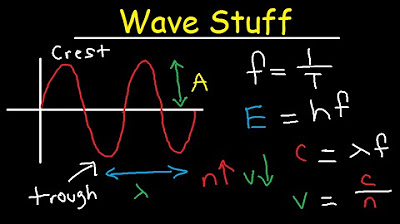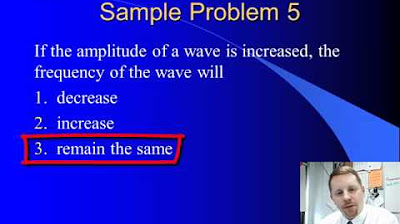Topic 26: Bode Plots (and a little PSpice)
TLDRThis video delves into first-order RC filters, focusing on their frequency response and the concept of corner frequency. It explains how the response in decibels (dB) changes with frequency, and introduces the Bode plot as a log-log representation of a filter's amplitude response. The video also discusses the rolloff rate, which increases with the order of the filter, and demonstrates how to simulate a first-order low-pass filter using P-Spice, highlighting the practical application of theoretical concepts.
Takeaways
- 📊 First-order RC filters are discussed, including low pass and high pass types.
- 📈 The response equations are derived, relating input frequency and corner frequency to the filter's output.
- 📉 At the corner frequency, the filter's response is down to 0.707 times the maximum value, corresponding to -3dB.
- 🔢 Decibel (dB) calculations are used to express the response ratio, with a 10-fold change in response resulting in a 20dB shift.
- 📌 Bode plots are introduced as a way to represent the filter's amplitude response in dB versus the log of frequency.
- 🚀 Asymptotic responses are explained, showing the filter's behavior as frequency approaches zero or infinity from each side of the critical frequency.
- 📉 The rolloff rate for filters increases with order: first-order filters have a -20dB per decade rate, second-order filters have a -40dB per decade rate, and so on.
- 🌟 Higher-order filters get closer to the ideal brick wall response, though it's unattainable.
- 📈 Log-log graphs (Bode plots) are preferred for expressing frequency response as they compress a wide range of responses into a manageable span.
- 🛠️ PE (Plain Old) Spice is used for circuit simulation, with a focus on a first-order low pass filter example.
- 🔍 The simulation includes setting up the circuit, input voltage source, and analysis parameters, with results displayed on a spectrum analyzer format.
Q & A
What is the main topic of the video?
-The main topic of the video is first-order RC filters, specifically focusing on their frequency response, Bode plots, and a demonstration of their analysis using PSpice.
What are the two types of first-order RC filters discussed in the video?
-The two types of first-order RC filters discussed are the low-pass filter and the high-pass filter.
How is the response of a filter represented in decibels (dB)?
-The response of a filter in decibels is calculated by taking the logarithm of the output voltage over the input voltage (Vout/VN), multiplying by 20. For example, at the corner frequency, the response is -3dB, which corresponds to 0.707 times the maximum value.
What is the significance of the corner frequency in a first-order RC filter?
-The corner frequency is the frequency at which the filter's response drops to 0.707 times the maximum value, which is a decrease of 3dB. It is a critical point that defines the transition band of the filter.
How does the rolloff rate change with the order of the filter?
-The rolloff rate increases by 20 dB per decade for each increase in the order of the filter. For example, a first-order filter has a rolloff rate of -20 dB per decade, a second-order filter has a rolloff rate of -40 dB per decade, and so on.
What is a Bode plot?
-A Bode plot is a logarithmic plot of a system's frequency response, typically with the amplitude response in decibels (dB) on one axis and the logarithm of the frequency on the other axis.
Why are log-log graphs used to express frequency response?
-Log-log graphs are used because they allow for a clearer representation of the filter's asymptotic behavior and make it easier to extract information about the filter's response over a wide range of frequencies.
How does the video demonstrate the analysis of a first-order RC filter?
-The video demonstrates the analysis by using PSpice to simulate a first-order low-pass filter circuit. The simulation includes setting up the circuit schematic, configuring the input voltage source, and performing a frequency sweep analysis to plot the filter's response in decibels.
What is the critical frequency of the simulated circuit in PSpice?
-The critical frequency of the simulated circuit is approximately 1 kHz.
What is the rolloff rate of a first-order low-pass filter in decibels per decade?
-The rolloff rate of a first-order low-pass filter is -20 dB per decade.
What is the relationship between decibels (dB) and the ratio of two voltages?
-The relationship is given by the formula: dB = 20 * log10(Vout/VN), where Vout is the output voltage and VN is the input voltage.
Outlines
📚 Introduction to First-Order RC Filters and Bode Plots
This paragraph introduces the topic of first-order RC filters, focusing on low pass and high pass configurations. It reviews the schematics and response equations derived in a previous video, highlighting the corner frequency where the response drops to -3dB from the maximum value. The concept of Bode plots is introduced, explaining how the response in decibels (dB) is represented versus the log of frequency. The paragraph also discusses the representation of gain for amplifiers and filters, and the significance of the corner frequency in determining the response ratio and decibel values.
📈 Decibel Response and Rolloff Rates
This section delves into the mathematical representation of filter responses, explaining how changes in response ratios correspond to decibel values. It details the rolloff rate, which indicates how quickly the filter response decreases with frequency, and how this rate varies with the order of the filter. The paragraph establishes that a 20 dB per decade rolloff rate for a first-order filter, with each increase in order leading to a 20 dB increase in rolloff rate. It also touches on the equivalence of a 20 dB per decade change to a 6 dB per octave change, emphasizing the use of decades in filter analysis.
🔌 PE Spice Simulation of First-Order Low Pass Filter
The speaker walks through the process of simulating a first-order low pass filter using PE Spice. The paragraph outlines the steps to create a circuit schematic, including placing components such as resistors, capacitors, and a sinusoidal voltage source. It describes the setup of the input voltage source and the configuration for a frequency sweep analysis. The simulation results are discussed, showing the filter's response in decibels across a range of frequencies, and the corner frequency's impact on the response is highlighted. The paragraph concludes with a brief mention of future videos that will explore PE Spice in more depth.
🎓 Conclusion and Future Outlook
In the concluding paragraph, the speaker summarizes the key points discussed in the video, including the analysis of first-order RC filters and the use of Bode plots for understanding their frequency response. The simulation results using PE Spice are referenced to reinforce the concepts learned. The speaker also teases future content, promising more in-depth exploration of PE Spice and other circuit analysis tools, encouraging viewers to stay tuned for upcoming videos.
Mindmap
Keywords
💡First-order RC filters
💡Decibel (dB)
💡Corner frequency
💡Bode plot
💡Asymptotic response
💡Rolloff rate
💡Logarithmic scale
💡Spice simulation
💡Frequency sweep
💡Linear response
Highlights
Continuation of the discussion on first-order RC filters, including decay response and Bode plots.
Review of the schematics for the first-order RC low pass and high pass filters from the previous video.
Explanation of the response equations derived in the last video, with a preference for the version in terms of input frequency and corner frequency.
Introduction to the concept of the corner frequency, where the response is down to 0.707 times the maximum value.
Conversion of the response from linear to decibels (dB) for amplifiers and filters.
Table of decimal values corresponding to different response ratios, such as 0 dB, -3 dB, and the 3 dB increase.
Explanation of the relationship between response changes and dB values, with a 10-fold change resulting in a 20 dB shift.
Definition and explanation of a Bode plot, which is a log-log amplitude response plot.
Discussion on the asymptotic response of filters and how it relates to the rolloff rate.
Comparison of rolloff rates for different filter orders, with each increase in order resulting in a 20 dB increase in the rolloff rate.
Explanation of why log-log graphs are used for expressing frequency response, and their advantage over linear graphs.
Introduction to the concept of decades and octaves in the context of filter response.
Demonstration of a PSpice simulation for a first-order low pass filter with a critical frequency of 1 kHz.
Step-by-step walkthrough of creating a circuit schematic in PSpice, including component placement and wiring.
Setting up of the input voltage source and the parameters for the sine wave function generator in PSpice.
Performing a frequency sweep analysis in PSpice, sweeping from 10 Hz to 100 kHz in decades.
Visualization of the filter response in decibels across different frequencies using PSpice.
Confirmation of the theoretical -3 dB drop at the corner frequency through PSpice simulation.
Overview of the practical application of PSpice for circuit analysis and the promise of deeper exploration in future videos.
Transcripts
Browse More Related Video
5.0 / 5 (0 votes)
Thanks for rating:





